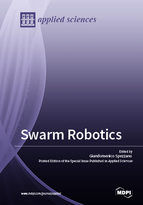Swarm Robotics
A special issue of Applied Sciences (ISSN 2076-3417). This special issue belongs to the section "Computing and Artificial Intelligence".
Deadline for manuscript submissions: closed (31 August 2018) | Viewed by 64753
Special Issue Editor
Interests: Internet of Things; learning (artificial intelligence); energy management systems
Special Issues, Collections and Topics in MDPI journals
Special Issue Information
Dear Colleagues,
Swarm robotics is a new approach to coordinate the behaviors of large numbers of relatively simple robots in a decentralized manner. It is based on the use of local rules and robots that are simple in comparison to the complexity of the task to achieve, and is inspired by social insects. Large numbers of simple robots can perform complex tasks in a more efficient way than a single robot, giving robustness and flexibility to the group. Robotic systems built on swarm intelligence show high efficiency, parallelism, scalability and robustness.
The area of swarm robotics will also benefit from the Internet of Things (IoT). Swarm robots will be able to communicate with each other and other objects around them through the cloud. The computational power will be supplied in the cloud and many of the robotic sensors required will be available from objects around them.
The potential applications of swarm robotics include tasks that demand miniaturization, like distributed sensing tasks in micro machinery or the human body. On the other hand, swarm robotics may be suited to the tasks that demand cheap designs, such as mining or agricultural foraging. Swarm robotics can be also involved in tasks that require large space and time costs and are dangerous to human beings or the robots themselves, such as post-disaster relief, target searching, or military applications.
In this Special Issue we want to address recent advances in the following topics:
-
Challenges and problems in swarm robotics
-
Advances in swarm robotics
-
Cooperative control
-
Modeling and simulation
-
Swarm intelligence
-
Design of emergence
-
Swarms of drones
-
Biomimetics and bio-inspired robotics
-
Multi-agent systems
-
Decentralized control and distributed systems
-
Modeling methods for swarm robotics
-
Self-organization and self-assembly
-
Collective movement and task allocation
-
Control algorithm for drone swarms
-
Collective transport of objects
-
Collective mapping
-
Swarm robotics and behavior models
-
Local sensing and communications
-
Safety analysis of swarm robotics
-
Develop methodologies and practises
-
Swarm of medical nanorobots for fight cancer
-
Robot algorithms development (software)
-
Cooperative Robotics in IoT Ecosystems
-
The Internet of Robotic Things
Submissions are invited for both original research and review articles. Additionally, invited papers based on excellent contributions to recent conferences in this field will be included in this Special Issue. It is hoped that this collection of high-quality works in swarm robotics will serve as an inspiration for future research in this field.
Dr. Giandomenico Spezzano
Guest Editor
Manuscript Submission Information
Manuscripts should be submitted online at www.mdpi.com by registering and logging in to this website. Once you are registered, click here to go to the submission form. Manuscripts can be submitted until the deadline. All submissions that pass pre-check are peer-reviewed. Accepted papers will be published continuously in the journal (as soon as accepted) and will be listed together on the special issue website. Research articles, review articles as well as short communications are invited. For planned papers, a title and short abstract (about 100 words) can be sent to the Editorial Office for announcement on this website.
Submitted manuscripts should not have been published previously, nor be under consideration for publication elsewhere (except conference proceedings papers). All manuscripts are thoroughly refereed through a single-blind peer-review process. A guide for authors and other relevant information for submission of manuscripts is available on the Instructions for Authors page. Applied Sciences is an international peer-reviewed open access semimonthly journal published by MDPI.
Please visit the Instructions for Authors page before submitting a manuscript. The Article Processing Charge (APC) for publication in this open access journal is 2400 CHF (Swiss Francs). Submitted papers should be well formatted and use good English. Authors may use MDPI's English editing service prior to publication or during author revisions.
Keywords
-
Swarms of drones
-
Artificial intelligence
-
Machine learning
-
Cooperative control
-
Bio-inspired algorithms






